For many people suffering from cataracts, doctors suggest phacoemulsification as the most effective treatment for ailment. Unfortunately, few people agree to this effective and generally safe procedure, for fear of a severe rehabilitation period, loss of vision or complications after surgery. And in vain, because in most cases, this procedure is easy and without any unpleasant consequences for the patient. In order to help you decide on such treatment, let's examine in detail what is this method of dealing with cataracts, what preparatory measures and further care it provides, and who can be shown.
Phacoemulsification is a cataract surgery with a special lens.. It is indicated for patients who, apart from the cataract itself, do not have other diseases. For them, this procedure has a good prognosis and in most cases leads to full recovery.
Phacoemulsification is performed using a special microscope and high-precision instruments that allow working through a minimal incision without injuring other eye tissues. For the complete comfort of the patient, it is performed under local anesthesia, and general anesthesia is practically not used here.
Unlike other methods of treatment, this operation can be assigned to the patient before it “catches” cataracts. It does not require hospitalization and allows a person to return to normal life almost the day after.
Features of the procedure
The main feature of this procedure is the removal of the lens and the subsequent introduction of the lens through a small-sized incision - up to 3 mm in total (compared with the incision with the other 10 mm). This was achieved by crushing the cataract itself by ultrasonic treatment and subsequent removal of its granules, for which a large opening in the mucosa was not required.
As a result of the development of such technology in the 1960s, doctors managed to reduce the time of operation of the operation, as well as to abandon the need to stitch after it. Today, phacoemulsification carried out according to such standards provides for only 20 minutes of the most manipulation, about 10 minutes of preparation and 24 hours full for each patient.
Patient preparation
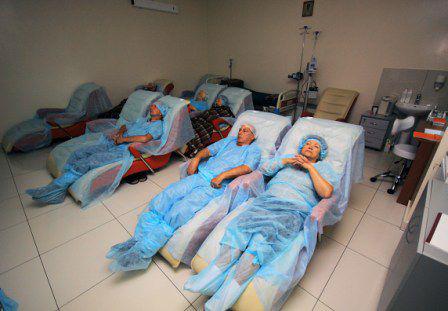 Preoperative preparation of the patient to replace the lens by phacoemulsification consists in taking special medications designed to strengthen the body, and also to eliminate the development of complications immediately after surgery. The period of preparation, as well as the type of medications necessary for it, is selected for each patient individually.
Preoperative preparation of the patient to replace the lens by phacoemulsification consists in taking special medications designed to strengthen the body, and also to eliminate the development of complications immediately after surgery. The period of preparation, as well as the type of medications necessary for it, is selected for each patient individually.
An important role in the success of such an intervention is also played by the general condition of the patient before the operation. It is precisely because patients who are willing to conduct phacoemulsification are advised to switch to a normal daily regimen a few weeks before it, excluding spicy, salty, and fatty, as well as stop drinking alcohol and nicotine for a while. This will help the person to transfer the procedure and recovery period more easily.
Immediately before the operation, the patient is prepared as follows:
![]()
- the eyes are washed before the operation, the skin around them is sterilized;
- special curtains are attached to the patient’s head and shoulders, limiting his view;
- the patient is asked to focus on the light of the operating microscope, then a special dilator is installed on the eye so that it remains open throughout the procedure.
After these preparatory activities, the doctor proceeds to the operation itself.
Phased process
Phacoemulsification has a universal algorithm with the following sequence of actions:
- A doctor with a diamond tool makes a micro-cut of no more than 1.8-3 mm, through which further leads all the manipulations.
- A viscoelastic is inserted through the cannula into the anterior chamber of the eye. - a substance that provides the internal structures of the eye protection against mechanical and ultrasonic effects directly during the operation.
- Through a micro incision, the doctor inserts a probe, through which the lens affected by cataract is converted into an emulsion.
- A flexible intraocular lens is inserted through the incision, which will continue to play the role of the affected lens. After the introduction, it turns around and fixes itself.
- Through the irrigation solution, the entire mass of viscoelastic is removed from the chambers of the eye. The operation at this stage is considered completed.
At the end of the operation, the seams to the incision site are not superimposed, since the micro incision is always self-sealing.
The patient can be discharged from the clinic on the same day and return to the normal rhythm of life. He needs until complete recovery only to perform individual.
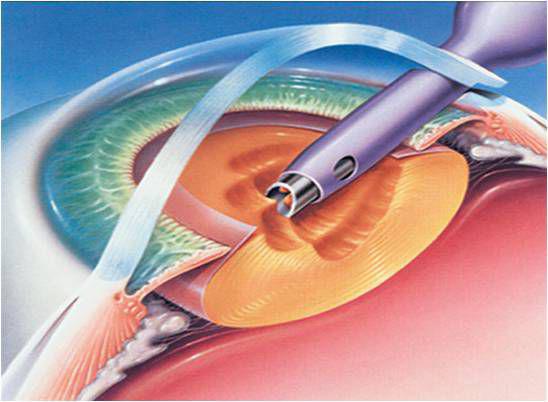
Postoperative period
After phacoemulsification, the patient is recommended to remain at rest for 24 hours. If he was worried before the procedure, bed rest may be indicated. It is allowed to eat the patient within 2 hours after the operation, but initially it is recommended to restrict himself to light snacks. A special bandage is put on the eye.
The first control examination is usually prescribed the next day after surgery, at the same time, the next dressing is also performed. Next, the patient will need to come to the doctor for examination after 7 and 14 days after surgery.
At this time, the patient may experience photophobia, the appearance of dark spots in the eye, discomfort, and increased fatigue. All these symptoms are purely individual, and their appearance depends on the general condition of the body. They are situationally cleaned with medicines.
In the event that a patient after surgery has vomiting or severe nausea, fever and dizziness, you should consult a doctor. These symptoms usually disappear very quickly and are easily removed with medication, but you should not try to eliminate them yourself.
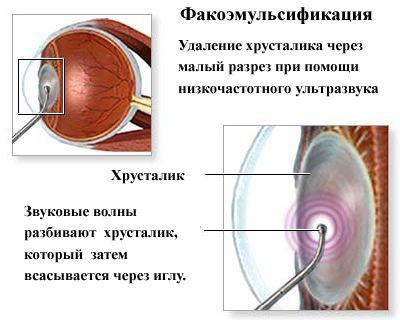 Also, the lens can be diluted so that he himself later goes out through the tear ducts.
Also, the lens can be diluted so that he himself later goes out through the tear ducts. In order for the process of recovery to take place easily and without complications, it is recommended to follow these general recommendations in the first 2-3 weeks after the operation:
- Wear sunglasses when going outside to avoid eye injuries;
- To refrain from touching the operated eye;
- Reduce the burden on vision, temporarily abandon long-term work at the computer or reading;
- Abandon driving vehicles.
To speed recovery from surgery, it is recommended to stick to a diet, reject heavy, greasy food, and also ensure that the hygienic recommendations of the operated place are followed correctly.
For the rest, the recovery process after such treatment does not have any specific strict prescriptions for care.
- modern low-impact cataract removal method, microsurgical intervention using ultrasound, which allows you to restore vision in patients with cataracts.
A cataract is a disease that is progressively clouded, and the person notices that the visible images become blurred. There are many treatments for cataracts. In the initial stages, drug therapy is applied, eye drops with microelements, vitamins. Such treatment allows you to stop the progression, but can not completely cure the disease. Surgery is necessary to completely eliminate cataracts.
Most often for cataracts such an operation as phacoemulsification is used - a fifteen minute bloodless procedure that is performed through a micro section, and suturing is not required. During the operation, the opaque lens is exposed to ultrasound, is removed, and in its place an artificial one is implanted (). Currently, it is the most effective and safest cataract treatment method used in world practice. The method has been worked out in detail, characterized by low invasiveness.
The essence of the method of phacoemulsification
Phacoemulsification is carried out using an ultrasound probe. The essence of the method consists in the crushing of a cloudy lens with ultrasonic waves and the subsequent suction of its particles. The impact is carried out only on the damaged lens, all other eye tissues are protected. The size of the micro incision is only 3 mm, thanks to which the restoration is quick, no sealing of the sutures is required, the risk of postoperative complications is significantly lower than with other methods.
Removing a cloudy lens does not restore vision, because the lens is a necessary element of focusing the image. Therefore, after removal of the damaged lens destroyed by ultrasound, an artificial intraocular lens is replaced in its place.
IOL implantation
The intraocular lens in a rolled-up form is inserted into the eye through a micro incision. It is then properly placed in the capsule. Artificial lenses are made from biocompatible materials, they serve for life and do not require replacement. An artificial lens is selected with the help of a special computer program for each patient individually, taking into account the specifics, therefore a correction is made or.
Advantages of the method
The operation of phacoemulsification was previously contraindicated in patients with a mature form of cataract, however, at present, the technology has improved, and the range of application of this intervention has been expanded. Phacoemulsification with IOL implantation can be performed in patients with dense cataracts, dystrophy, lens subluxation and other diseases. In addition, it is a method of choice in the presence of severe somatic pathology or complicated cataracts, the risk of postoperative complications is minimal. No restrictions on age.
The indisputable advantages of the method are:
- no distortion after the operation;
- the possibility of treatment in the initial stages of cataracts;
- replacement of a cloudy lens with an intraocular lens.
The operation itself takes no more than 30 minutes, is performed under local anesthesia, general anesthesia is not required. The patient does not need to stay in the hospital and goes home a few hours after the operation.
Video phacoemulsification surgery with IOL implantation
Cost of operation phacoemulsification
Phacoemulsification price with IOL implantation in ophthalmology clinicsmoscow is different, it starts from 35 000 rubles, depends primarily on the choice of artificial lens, which will be installed, as well as the equipment of the clinic, the qualification of the ophthalmosurgeon.
Phacoemulsification clinics with IOL implantation
You can familiarize yourself with the prices of all ophthalmologic clinics in Moscow where cataract phacoemulsification is carried out.
Cataract phacoemulsification is an innovative method of removing the diseased lens through an ultra-small incision. The method was developed in the middle of the 20th century by ophthalmologist C. Kelman. His method of extraction of the damaged lens of the eye is the "pearl" of ophthalmic surgery.
Description of the extraction method
The method is based on the previously popular extracapsular extraction of the lens and is its kind. The operation - phacoemulsification - refers to the so-called energy interventions performed with the help of energies: laser, ultrasound.
Today, this technique is used everywhere, but according to the testimony other methods of cataract extraction are used:
- extracapsular extraction (EEC);
- intracapsular extraction (IEC);
- phacoemulsification with ultrasound (FEC);
- laser phacoemulsification (Femto-Cataract);
- eEC and IEC are gradually being replaced by less traumatic ones - ultrasound and laser phacoemulsification.
Ultrasonic removal method
The essence of the method is that the working part of the phacoemulsifier is introduced into the anterior chamber of the lens of the organ of vision through an incision no larger than 2-3.2 mm.
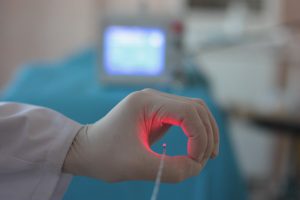
Ultrasound phacoemulsification method
An ultrasonic signal of a strictly defined force is applied to it, which causes the element affected by the cataract to emulate. Then, through a system of hollow tubes, with which the tip of the device is supplied, a special solution is fed, which “washes out” the crystalline lens. Through the same devices the emulsified substance is removed.
The method continues to be improved. Today, a seamless surgical method is used, based on self-closing incisions, which made it possible to reduce in time and reduce the effect of ultrasound to avoid injury to the surrounding lens tissue and shorten the rehabilitation period.
However, this method of extraction is contraindicated in certain types of diseases. Ultrasonic extraction can not be used:
- with secondary cataracts;
- with concomitant narrow-angle glaucoma;
- with a solid core (brown);
- with dystrophic changes in the cornea.
Ultrasonic phacoemulsification of cataracts is not carried out in the presence of a very dense, so-called “brown” core, since it is necessary that the energy be applied with the maximum power and for a long time.
At the same time there is a high risk of damage to eye tissue. A variation of the cataract phacoemulsification method is the effect of laser energy on it.
Progress in the field of medical instrumentation has led to the emergence of various variants of this method, which are based on the use of the energy of laser systems:
- extreme laser;
- short pulse laser (Er: YAG);
- solid-state laser (Nd: YAG), etc.
The basis of the unique domestic method of laser phacoemulsification of cataracts is the use of a solid-state beam with a wavelength of 1.44 microns.
It crushes the core with maximum density without damaging the eye tissue. In addition, laser systems used in ophthalmology allow you to accurately predict the result of the operation.
Algorithm of the operation
Preparation for the operation takes place in advance. The patient is prescribed medications that reduce the risk of postoperative complications. The algorithm for the manipulation is as follows:
- The patient is placed on the operating table, the eye is fixed with a special dilator and is isolated by a shield system.
- Anesthesia is carried out, as a rule, in the drop way. Sometimes it is combined with patient sedation. At the same time he is conscious, but relaxed.
- The surgeon makes a micro incision in one of the ways (scleral, corneal, limbal) through which the working part of the ultrasound or laser apparatus is inserted.
- The eye is filled with a viscous fluid (Viscoelastic) to reduce the traumatic effect of radiation on eye tissue.
- Through a micro incision, a continuous circular incision (capsulorhexis) of the anterior chamber of the lens is made.
- In order to release the lens, hydrodissection is performed - “rocking” it with the help of a jet of water injected under the capsule.
- Ultrasound energy destroys the structure of the lens. At the first stage, the most dense part of the lens, its core, is crushed. Then the lens cortex is treated, but the surgeon leaves the posterior capsule that will support the implant.
- The remains of the lens out through the aspiration system. The procedure for introducing a fluid to “wash out” the emulsified lens and its aspiration occurs simultaneously. At the same time, the posterior part of the capsule is cleaned from the epithelial cells of the lens.
- After the “polishing” is completed and the camera is cleaned, a folded artificial optical lens (IOL) is placed in the capsular bag with the help of an injector, which serves as a replacement for the removed lens.
- Viscoelastic, insulating tissue is removed.
- Seams are not imposed, the surgical incision is sealed
- The operated eye is closed with a bandage-guard.
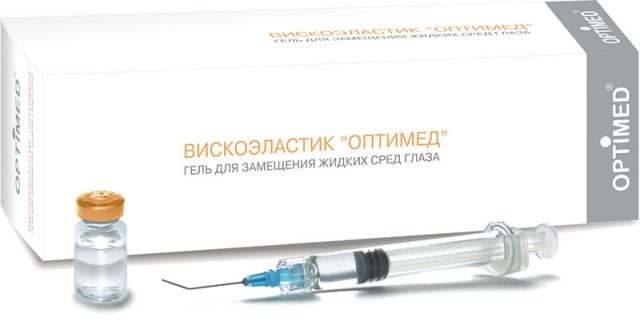
How the operation is performed - phacoemulsification of cataracts with IOL implantation - the video tells in detail. The whole procedure takes no more than 20 minutes.
Types of lenses used
To restore vision, cataract phacoemulsification with IOL implantation is performed using intraocular implants made of different materials:
- polymethyl acrylate - easy and convenient to process;
- silicone.
Currently there are more than 300 IOL models, but the development of more advanced implants has not been completed.

Ultraviolet radiation is harmful to the operated eye, so special IOLs are manufactured. The lens of the lens absorbs UV radiation, protecting the retina from damage.
Not all patients are shown intraocular lenses. In case of hypersensitivity to the materials of which the IOL is made, contact and spectacle lenses are used. With the threat of rejection of the IOL or associated ophthalmic pathologies, contact lenses are placed on the patient.
Quite a small percentage of operated patients can not tolerate even contact lenses. They are prescribed glasses, which have many disadvantages compared to the latter. Among them:
- the eye is unable to focus;
- narrows the field of view;
- on the periphery from the central axis of view, the outlines of objects blur.
The cost of cataract phacoemulsification with IOL implantation depends on many factors and varies from 25 thousand to 150 thousand rubles per eye.
The price depends on the level of the clinic in which the operation is performed, the qualifications of the surgeon, the chosen implant model. In Ukraine, the operation with implantation of a flexible IOL costs, depending on the lens model, from 6,800 to 36,300 UAH.
Benefits of the Extraction Method
 The phacoemulsification method has the following advantages over the classical method:
The phacoemulsification method has the following advantages over the classical method:
- held on an outpatient basis;
- safe local anesthesia is used;
- does not require suturing, which reduces the risk of postoperative complications;
- carried out as soon as possible and does not require long-term rehabilitation;
- allows you to restore vision in full;
- has a minimum of limitations in the postoperative period.
Improving installations for the operation and the development of new models of artificial lenses reduce existing minimal risks.
This method allows you to intervene in the early stages of a cataract, without waiting for it to mature, which significantly reduces the risk of postoperative complications and reduces the cost of the manipulation itself.
Postoperative patient care
After surgery, the patient must rest for at least a day. It is recommended to eat food only after a few hours, and the food should be light. Some patients may have subjective complaints of pain, burning, itching in the operated eye.
In addition, temporary reactions may occur in the form of dark spots in the field of vision, hypersensitivity to light, hemorrhage, edema. All these violations take place within a few weeks.
Patients after surgery are prescribed medication in the form of drops, which are used to exclude infection and normalize intraocular pressure. They are recommended to use another 1 month after the intervention.
For 2-3 weeks it is recommended to go out in sunglasses or a bandage, do not rub the eyes. Unlike other methods of extraction, after phacoemulsification, the patient can get to work and lead a normal life almost immediately. Periodically it is necessary to come to the doctor to monitor the condition of the eyes.
Video operations
Phacoemulsification is the removal of a cataract using an ultrasound probe by crushing and sucking through a 3 mm wide micro incision (as opposed to the old method, where a 13–15 mm incision is used). This incision does not require sealing seams, reduces the healing time to 10 days and allows you to avoid the above complications.
Especially for this operation was created soft artificial lens with shape memory - “miracle lens”. Through the same micro-cut, the lens rolled up into the tube is inserted into the place of the removed own lens with the help of special syringes - injectors or tweezers.
An artificial lens is calculated for each patient individually using a special computer program. At the same time, simultaneous correction of myopia and hyperopia is possible.
ANESTHESIA for cataract removal surgery.
The operation is performed under local anesthesia, which is achieved by instillation of drops. Patients with no pain.
Cataract removal with the phacoemulsification (PE) method is preferable in patients with complicated cataracts and in patients with severe somatic diseases, since creates less prerequisites for the emergence and development of intra- and postoperative complications. Until recently, indications for phacoemulsification surgery were narrowed and were performed only in patients with immature cataracts. But thanks to the developments carried out and implemented in NPTSVZ, it became possible to perform operations in patients with narrow pupils, mature (dense) cataracts, subluxation of their own crystalline lens, corneal dystrophy, after various injuries of the eye and other diseases that had not previously been done anywhere.
When carrying out cataract phacoemulsification according to the methods developed in NPCVZ, visual acuity is 15–20% higher than after a cataract removal operation with a large incision. It reaches the maximum possible value and corresponds to the norm of the eye. Visual impairment is possible only at the expense of other eye diseases (for example, when a cataract is combined with damage to the optic nerve or retina), which the surgeon warns the patient in advance.
All the doctors of our center have been trained and trained in the leading medical institutions of the world and have the appropriate certificates. Our specialists at the center conduct training of doctors and surgeons from various cities of Russia and the CIS countries in modern phacoemulsification techniques.
All patients NPTSVZ undergo a full course of postoperative follow-up care. It consists in the dynamic observation of patients for the entire period necessary for the full visual and labor rehabilitation.
The rich surgical and clinical experience of the doctors of our center, the availability of all the necessary equipment and excellent working conditions, as well as attentive and kind attitude to everyone, ensure the maximum result of treatment.
The progress of the cataract removal operation
Step 1. An incision is made, more like a puncture - less than 3 mm. Unlike the “traditional technique”, where the incision reaches 15 mm. This puncture has the property of self-sealing and does not require the imposition of a seam. This significantly reduces rehabilitation time and avoids complications. Stage2. With the help of an ultrasound probe, the opaque lens is crushed into small particles with their simultaneous suction. In the case of the use of technology, Aqualize crushing is performed by a stream of fluid, which is less traumatic and more secure for the patient's eye. Stage 3. Through the same incision, a soft artificial lens rolled into a tube with the help of a special syringe injector is implanted into the eye. The whole operation lasts from 4 to 10 minutes.
Cataract removal procedures using the phacoemulsification method in the Vision Restoration Center are performed by Dr. med. Yousef Naim Yousef
New vision for an hour ?!
Usually, after operating, visual acuity is fully restored only for distance. It is also possible to reduce vision due to concomitant diseases. This the surgeon must warn in advance.
What is the secret of this miracle technology?
Phacoemulsification is the removal of the lens from the eye with the implantation of an artificial intraocular lens (IOL). The operation is performed on an outpatient basis. The procedure is considered to be the most perfect, well thought out, safe and less traumatic of all existing methods of cataract surgical treatment.
Advantages of phacoemulsification:
- Removal of virtually any cataracts.
- The incision of the eye shell is only 3 mm, so suturing is rarely required.
- Undisturbed vision after surgery.
- Implantation of various IOLs - rigid, flexible, etc.
- Short rehabilitation period.
- No age limit.
Of course, not everything is so rosy. Complications are not excluded here, but their percentage is significantly reduced compared with other operations.
Step by step operation
Phacoemulsification is performed using a cannula and ultrasound. The outer shell of the eye is incised with a special diamond knife:
A cannula is inserted to crush and remove lens particles from the eye:
Under the influence of ultrasound, the needle begins to break up the lens in the hammer drill mode. At the same time, fluid is pumped into the eye and pumped out, and fragmented fragments of the lens are removed. The pink pupil indicates a complete cleansing of the capsule:
IOL is folded into a cleaned capsule when folded:
The needle is removed, the lens unfolds and takes the necessary position:
Done! After that, a bandage is applied, and after 2-3 hours the patient is allowed to go home. If desired or in difficult cases, hospitalization for 1-2 days may be indicated.
So as not to hurt
Basically phacoemulsification is performed under local anesthesia. That is, anesthesia is achieved by instillation of drops in the eye. Additionally, intravenous injections of an anesthetic agent are made.
In order for their impact to come into full force, they wait half an hour and only then the operation begins. The patient is conscious all this time, but at the same time does not feel pain.
Drops used for anesthesia, have a “freezing” effect. This is what allows the removal of cataracts without pain. An injection is made into the skin around the eye. This temporarily turns off the eye, making it and the eyelids immovable.
After surgery, the anesthetic effect disappears during the day and the sensitivity of the eye is restored. Each method of anesthesia is good and bad in its own way, so the doctors select the options individually.
Separately about intraocular lenses
We have already casually mentioned that phacoemulsification is performed with the implantation of any IOL. And it is true. Today, there are many models that allow to solve these or other eye problems. Consider some of them.
Monofocal lens. Used in most operations. Advantage - excellent vision into the distance. But for the near need additional correction in the form of points or contact lenses.
By the way, reviews of people on phacoemulsification on the Internet are often associated with this issue, as they are waiting for a full recovery of vision. But when installing a monofocal IOL, visual acuity reduction for nearness is logical, as is the occurrence of astigmatism.
Accommodating lens. Used if the patient does not want to wear glasses after the removal of the cataract. Together with its implantation, visual acuity improves: both for distance and near. Simply put, there is an imitation of accommodation in youth. Suitable for those who spend a lot of time on visual work.
Multifocal lens. It allows you to see without glasses at any distance, and the action is similar to multifocal glasses. Such an IOL is especially good for the correction of presbyopia.
Aspherical lens. Widely applied abroad. With the implantation of such a lens, vision becomes like that of a young falcon! This is a high quality of vision and high contrast sensitivity. Suitable for those over 40.
Toric lens. Allows you to correct astigmatism to 12 D! It is made individually, taking into account all the features of the eye, in which it will be installed. Disadvantages: high cost and long term production of the IOL - about 2 months.
The video is not for the faint of heart and impressionable:
Given that cataract phacoemulsification is truly a masterpiece of jewelry art, the disadvantages of the operation are more than worth the advantages. Even not very good vision is better than total blindness.
And what do you think about this operation? Have you ever encountered her in person? What feelings did you have? Share your experience or opinion with us! We are waiting for your feedback and comments! Do not skimp on words, because you can help other people!
The method of phacoemulsification in the treatment of cataracts - a guarantee of quality and reliability
A cataract is a complete or partial blurred eye. As a result of this disease, the eye gradually becomes clouded. If you do not treat this ailment in a timely manner, the organ of vision becomes completely cloudy and the person becomes blind. Phacoemulsification is considered the most modern, painless and effective treatment. This ultrasonic phacoemulsification does without stitching, since only the newest technologies of modern times are used.
In order to carry out the operation of phacoemulsification, it is not necessary to wait until the cataract is fully mature, and also to tolerate this decline in vision. Since the time during which it matures may be about ten years, man had to radically change his rhythm of life. He quit his job, stopped getting behind the wheel of a car, began to experience great inconvenience in case of insufficient lighting. Today, it is possible to conduct ultrasound phacoemulsification of cataracts even before the stage of full maturation, at a cost it will be even cheaper.
Risk of complications
and - the lens; b - sound waves break the lens, which is then sucked through the needle
Phacoemulsification has a number of distinctive properties from the other generally accepted methods of cataract operations, that is, before intra -, as well as extracapsular extraction. This method is considered the safest and less traumatic, because with it the opaque nucleus is crushed using ultrasound, and then removed using an aspiration system. Due to the fact that this incision does not subsequently require stitches, the risk of complications after surgery is reduced.
Ultrasonic phacoemulsification is considered to be such a perfect operation that there is almost no risk of complications after all stages. If we consider all cases of domestic and foreign medicine, then only 1% of patients in the most complex operations complained of complications after phacoemulsification. Possible complications include:
- Induced astigmatism after the entire course of the operation
- Inflammatory process
- Blurred back of the lens
- Corneal edema
- Cystoid macular edema
Complications after phacoemulsification are the most common and the last option. With this method of removal, it is worth paying particular attention to patients who suffer from diabetes, uveitis, a form of AMD. For the treatment of this complication, you will need to use corticosteroids, angiogenesis inhibitors.
The first item on the list can be attributed to fairly frequent complications - induced (postoperative) astigmatism. It can cause even the final function of the result of the operation to deteriorate. Its value will depend on what method of extraction was used, what was the localization and the length of the incision.
To correct this complication, you need to wear glasses or special lenses, in the event that the patient after phacoemulsification acquires pronounced signs of astigmatism, refractive surgery may be performed to remove and treat the complication.
Carrying out the operation process
Phacoemulsification operation:
- Phacoemulsification takes place with the use of a diamond tool during the course of action, the ophthalmologist will create a cut on the cornea of the eye, the length of which will be from 2 to 2.5 mm. Further, all manipulations and actions during phacoemulsification will be carried out only through it. This is the first step of ultrasonic phacoemulsification of cataracts.
- After the viscoelastic is injected by the doctor. This mixture is a special substance that is able to protect all internal structures of the organ of vision in the process of surgical intervention from exposure. Impacts can be of two types: ultrasonic and mechanical. With the use of viscoelastic, the ophthalmologist will be able to freely perform many manipulations.
- A special probe is inserted through an incision in the cornea, which allows using the ultrasound to transform the affected lens into a special emulsion.
- Further, such a move: through the same incision, a flexible intraocular lens is inserted, which is in the folded state. It alone can turn inside and securely lock. Now she can become a substitute for the lens.
- At the end of the surgery, the whole mass of viscoelastic is washed out of the chamber of the visual organ with the use of irrigation solution.
a) Sound waves break the lens affected by cataracts and are sucked through the needle; b) An artificial lens is gently implanted in the eye; c) The correct location of the IOL and the seamless closure of the inlet.
Benefits of early treatment
Torsion Ultrasound
Torsion Ultrasound
Torsion phacoemulsification is the last word in surgery. This method is much faster and more reliable than traditional phacoemulsification. This is considered a fundamentally new treatment option for cataracts. Torsional phacoemulsification, its advantages lie in the fact that torsional ultrasound gradually destroys the infected lens. Phacoemulsification of this type, includes the whole process when making oscillatory movements of the needle. Implanting iol in this case is more easily tolerated.
Story.
Phacoemulsification is a type of extracapsular cataract extraction. During the operation, the front lens capsule and the lens itself are removed.
Early the most popular cataract surgery method was the extracapsular extraction method. It included a large incision in almost half of the eye (about 10 mm). As a result of this operation, the risk of complications was quite high and the recovery period required almost a week-long hospitalization of the patient after the operation and various restrictions on physical activity for several weeks and even months.
In the late 1960s, Charles Kelman introduced cataract phacoemulsification to the world. His goal was to remove the cataract through a small incision with a short recovery time and reduce pain during the process itself. He found that a cataract can be broken into small pieces and emulsified using an ultrasonic tip. The process of introducing the method was rather slow. But the success of Charles Kelman was how convincing. that many surgeons began to gradually adopt his method. Over the past decade, surgeons are constantly improving this method to make it even safer and more successful. Innovation in lenses helps improve patient outcomes through small incision surgery.
How it's done?
Preoperative patient preparation aims to reduce the risk of complications for the patient. To do this, the attending physician prescribed the necessary medicines.
The patient's eye is washed before the operation and to limit the operative field, it is isolated with special sterile curtains that are placed on the patient’s head and shoulders. The patient must lie still and concentrate on the light of the operating microscope. For eyelids, the expander is inserted so that the eye is constantly open.
The general condition of the patient is monitored by an anesthesiologist. We perform this operation under combined anesthesia, which includes patient sedation and local anesthesia. This reduces the risk of general anesthesia to the patient. Patients do not sleep during surgery, but are in a relaxed state.
After the necessary anesthesia, the surgeon makes an incision of about 3 mm. After the incision is made, the eye is filled with a viscous fluid called a viscoelastic to reduce the shock of the intraocular tissues and for convenient operation of the surgeon. After this, capsulorhexis is made - a circular incision in the anterior capsule of the lens that surrounds the cataract. The next steps are hydrodesection, i.e. the release of the cataract with a jet of water from the lens cortex.
After the preparatory measures, phacoemulsification itself is performed using a small ultrasound probe that is inserted into the eye through the incision. This probe divides the lens into small pieces and removes fragments from the eye. First, the surgeon focuses on the nucleus of the lens, which is more dense. After its removal, the lens cortex is removed, but its posterior capsule remains. It is then used to support the IOL.
The folded IOL is inserted into the eye using an injector. A lens is inserted into the capsular bag. Viscoelastic is removed. Seams, as a rule, do not overlap.
The eye is closed by a bandage-guard.
The whole procedure takes about 20 minutes. The phacoemulsification procedure itself takes only a few minutes.
Why is this done?
A cataract causes loss of vision, which interferes with the patient’s daily activities. The only effective means of restoring a complete and clear vision that has been compromised by a cataract is to perform an operation to remove it and replace it with a permanent artificial lens.
Requirements for the patient.
Phacoemulsification with IOL implantation is ideal for people who do not have other eye diseases. All other patients have risks with such surgery. In any case, the issue is solved individually with the calculation of the degree of risk and the final decision is made by the doctor after examining the patient and discussing this situation with the patient. Of great importance is the general condition of the patient, since it can also affect the outcome of the situation. The degree of the overall risk of the operation is determined after a full examination of the general condition of the patient.
Aftercare
Immediately after surgery, the patient is taken to the ward and transferred under the supervision of the medical staff of the department. The patient needs rest for at least 24 hours. He can eat 2 hours after surgery. Light snacks are recommended.
It is normal that after surgery the patient may still be disturbed by drowsiness and discomfort may occur in the eye. All issues are resolved medication. For other side effects, such as severe pain, nausea or vomiting, consult a doctor immediately.
During the recovery period there may be subjective complaints of varying severity. Patients may see dark spots that should disappear within a few weeks after surgery. Discomfort and itching in the eye, pain and increased photosensitivity may be troubling. Some patients may have swelling and hemorrhages under the skin and under the conjunctiva of the eye. All this will pass with time without much treatment as the eye heals.
The next day after the operation, the patient is waiting for a dressing with an examination, prescribing the necessary treatment, which is aimed at preventing infection, regulating intraocular pressure, if necessary, and improving the recovery period. Drops are used within a month after surgery.
Patients are advised to wear an eye patch when going outside and refrain from wanting to rub their eyes for at least 2 weeks. It is recommended to wear sunglasses or glasses that were before the operation to prevent possible injury to the eye. Unlike other types of cataract extraction, patients can return to normal activity almost immediately after phacoemulsification.
Later we invite you to check-ups every week, if everything goes well and at any time, if the patient is worried about anything.
After a period of recovery, the patient may need new corrective glasses, at least for fine work and reading.
What is considered a good result?
Most patients regain their visual acuity after surgery, and some patients. who had refractive errors of varying severity throughout their lives, will have the best vision of their lives after IOL implantation.
Some patients will no longer need to use glasses or contact lenses after cataract surgery.
Patients will have better color perception, depth of space perception and they will be able to return to normal activities and their favorite activities, such as driving, reading and playing sports.
Complications and risks
Complications after cataract surgery are rare.
However, as with any operation, there are risks that include the possibility of such complications:
- Infection is a potential complication that requires additional prescription of antibiotics and in some cases hospitalization of the patient in a medical institution. One of the dangerous complications is endophthalmitis. This complication is much more rare, today due to new methods of surgery and strong broad-spectrum antibiotics.
- Retinal detachment is one of the possible serious complications. Most often, this complication occurs in patients with a compromised retina. Also, this complication can occur within a few weeks or months after surgery. Patients with retinal detachment require urgent surgical intervention. You should be wary if you have complaints about the swaying veil in the eye and be sure to contact us for inspection.
- Bleeding rarely occurs. It sometimes happens on an operating table or in the early postoperative period. A terrible complication is expulsive bleeding.
- Loss of vision as a result of described untreated or untimely treated conditions
- You may be disturbed by recurrent redness and swelling of the eye. Sometimes after surgery there is an increase in intraocular pressure, which can lead to glaucoma.
- Corneal edema
- The development of secondary cataracts. Sometimes in the late operating period (1–2 years after surgery) the posterior lens capsule may become cloudy. This is the so-called secondary cataract. To resolve this issue, YAG capsulotomy is used. A small hole is made with a laser. as a result, the person begins to see again. This is an outpatient procedure that does not require an incision.
Risks can be reduced if you correctly follow the prescriptions and recommendations of doctors before and after surgery. In addition, with early detection, almost all conditions are treatable, followed by complete recovery.
Morbidity and mortality
Mortality on the operating table or after cataract surgery with phacoemulsification is rare and is 0.05% worldwide. As a rule, this is due to the general condition of the patient and the possible consequences of general anesthesia.
Other serious complications such as blindness have also been reduced due to the widespread use of phacoemulsification. A good selection of antibiotics allows us to fight infections that previously caused blindness.
Cataract phacoemulsification should be performed in a specially equipped operating room, a surgeon with sufficient qualifications for it. Additionally, an anesthesia manual can be used.
It is a dangerous disease of the organs of vision, which often leads to complete blindness. The only effective way to cure the pathology is to remove the clouded areas of the lens that have ceased to function, and to install an artificial intraocular lens instead. Previously, surgical therapy consisted of manual tunnel extraction, now pharaoemulsification of cataracts with IOL implantation is being increasingly used as a more modern and high-tech technique.
What is cataract phacoemulsification with intraocular lens implantation?
The essence of the operation in question is the fragmentation and removal of dead (clouded) areas of the lens. In place of these non-functional areas, an implant is installed - a soft artificial intraocular lens. It has a shape memory and fully assumes the function of a damaged lens.
How does ultrasound cataract phacoemulsification proceed with IOL implantation?
The sequence of actions during the surgical intervention:
- Local anesthesia.
- Perforation of the incision along the periphery of the cornea up to 2 mm
- Introduction to the anterior chamber of the eye tip of the ultrasonic device.
- Simultaneous injection of viscoelastic to protect the internal eye structures.
- The formation of a cut on the lens capsule.
- Crushing and transformation of opacified areas into an emulsion.
- Suctioning of damaged lens tissue.
- Introduction through an incision on the capsule of a flexible IOL pre-rolled into a tube.
- Erosion of viscoelastic from the anterior chamber of the eye through irrigation solution.
Folded intraocular lens, getting into the cavity of the lens, straightens it yourself, getting the perfect shape and reliably fixing.
It is worth noting that, due to the microscopic size of the incision on the cornea, suturing is not required after the operation. Therefore, the recovery period takes a minimum period, and in general, surgery is not traumatic.
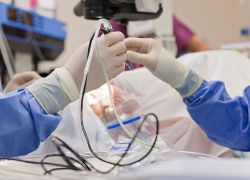
- In contact with 0
- Google+ 0
- OK 0
- Facebook 0







